« Society for Consumer Psychology 2005 Winter Conference | Main | Egon Brunswik »
January 13, 2005
Are the two birds in the bush a better choice than the one in your hand?
SEPERATE NEURAL SYSTEMS VALUE IMMEDIATE AND DELAYED MONETARY REWARDS
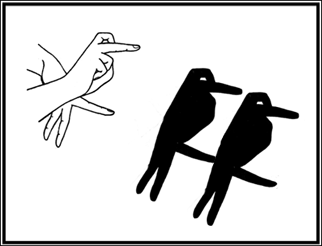
People seem to alternate between choosing to indulge in what is immediately available and choosing to decide based upon the knowledge that patience often wins in the long run. If you offer someone $10 today and $11 tomorrow, it's likely they will choose the $10 today. But if you offer someone $10 in a year and $11 in a year and one day, they'll probably choose the $11. The relative values of options may be discounted according to how long one expects to wait until payoff. To date little research has investigated the source of the tension between short-term and long-term preferences. A recent study in Science by Samuel McClure, David Laibson, George Loewenstein and Jonathan Cohen suggests that this discrepancy is due to the fact that two separate neural systems value immediate and delayed monetary rewards.
ABSTRACT:
"When humans are offered the choice between rewards available at different points in time, the relative values of the options are discounted according to their expected delays until delivery. Using functional magnetic resonance imaging, we examined the neural correlates of time discounting while subjects made a series of choices between monetary reward options that varied by delay to delivery. We demonstrate that two separate systems are involved in such decisions. Parts of the limbic system associated with the midbrain dopamine system, including paralimbic cortex, are preferentially activated by decisions involving immediately available rewards. In contrast, regions of the lateral prefrontal cortex and posterior parietal cortex are engaged uniformly by intertemporal choices irrespective of delay. Furthermore, the relative engagement of the two systems is directly associated with subjects' choices, with greater relative fronto-parietal activity when subjects choose longer-term options."
QUOTES:
"In Aesop's classic fable, the ant and the grasshopper are used to illustrate two familiar, but disparate, approaches to human intertemporal decision making. The grasshopper luxuriates during a warm summer day, inattentive to the future. The ant, in contrast, stores food for the upcoming winter. Human decision makers seem to be torn between an impulse to act like the indulgent grasshopper and an awareness that the patient ant often gets ahead in the long run. This research is unified by the idea that consumers behave impatiently today but prefer/plan to act patiently in the future."
"Impulsive preference reversals are believed to be indicative of disproportionate valuation of rewards available in the immediate future. Some authors have argued that such dynamic inconsistency in preference is driven by a single decision-making system that generates the temporal inconsistency, while other authors have argued that the inconsistency is driven by an interaction between two different decision-making systems. Specifically, we hypothesize that short-run impatience is driven by the limbic system, which responds preferentially to immediate rewards and is less sensitive to the value of future rewards, whereas long-run patience is mediated by the lateral prefrontal cortex and associated structures, which are able to evaluate trade-offs between abstract rewards, including rewards in the more distant future."
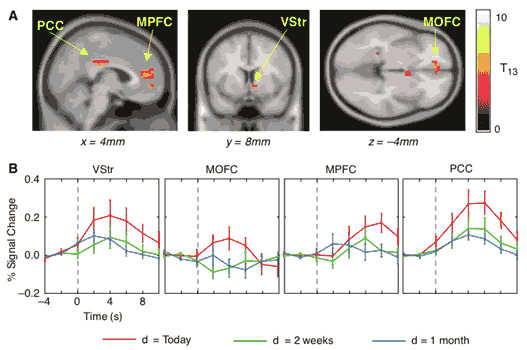
Brain regions that are preferentially activated for choices in which money is available immediately (Beta areas). (A) A random effects general linear model analysis revealed five regions that are significantly more activated by choices with immediate rewards, implying d 0 0 (at P G 0.001, uncorrected; five contiguous voxels). These regions include the ventral striatum (VStr), medial orbitofrontal cortex (MOFC), medial prefrontal cortex (MPFC), posterior cingulate cortex (PCC), and left posterior hippocampus (table S1). (B) Mean event-related time courses of Beta areas (dashed line indicates the time of choice; error bars are SEM; n 0 14 subjects). BOLD signal changes in the VStr, MOFC, MPFC, and PCC are all significantly greater when choices involve money available today (d 0 0, red traces) versus when the earliest choice can be obtained only after a 2week or 1-month delay (d 0 2 weeks and d 0 1 month, green and blue traces, respectively).
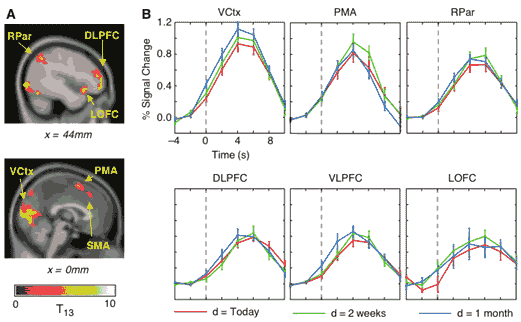
Brain regions that are active while making choices independent of the delay (d) until the first available reward (delta areas). (A) A random effects general linear model analysis revealed eight regions that are uniformly activated by all decision epochs (at P < 0.001, uncorrected; five contiguous voxels). These areas include regions of visual cortex (VCtx), premotor area (PMA), and supplementary motor area (SMA). In addition, areas of the right and left intraparietal cortex (RPar, LPar), right dorsolateral prefrontal cortex (DLPFC), right ventrolateral prefrontal cortex (VLPFC), and right lateral orbitofrontal cortex (LOFC) are also activated (table S2). (B) Mean event-related time courses for & areas (dashed line indicates the time of choice; error bars are SEM; n 0 14 subjects). A three-way analysis of variance indicated that the brain regions identified by this analysis are differentially affected by delay (d) than are those regions identified in Fig. 1 ( P < 0.0001).
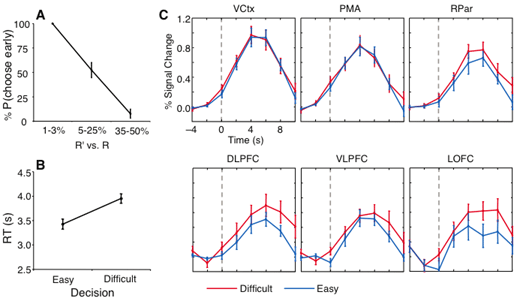
Differences in brain activity while making easy versus difficult decisions separate delta areas associated with decision making from those associated with non-decision-related aspects of task performance. (A) Difficult decisions were defined as those for which the difference in dollar amounts was between 5% and 25%. (B) Response times (RT) were significantly longer for difficult choices than for easy choices (P < 0.005). (C) Difficult choices are associated with greater BOLD signal changes in the DLPFC, VLPFC, LOFC, and inferoparietal cortex (time by difficulty interaction significant at P < 0.05 for all areas).
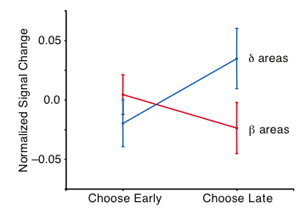
Greater activity in delta than beta areas is associated with the choice of later larger rewards. To assess overall activity among beta and delta areas and to make appropriate comparisons, we first normalized the percent signal change (using a z-score correction) within each area and each subject, so that the contribution of each brain area was determined relative to its own range of signal variation. Normalized signal change scores were then averaged across areas and subjects separately for the beta and delta areas (as identified in Figs. 1 and 2). The average change scores are plotted for each system and each choice outcome. Relative activity in beta and delta brain regions correlates with subjects' choices for decisions involving money available today. There was a significant interaction between area and choice (P < 0.005), with & areas showing greater activity when the choice was made for the later option.
ABOUT THE AUTHORS:
Samuel McClure
Samuel McClure is a post-doctoral fellow in the psychology department at Princeton University. He received his PhD in Neuroscience from the Baylor College of Medicine in 2003.
"Broadly, my research lies in the area of reward processing. I am interested in how we respond to motivationally salient events, learn to predict them, and translate this knowledge into decisions to act. My work has focused on appetitive salient event, or rewards, and how they drive changes in neural activity in the basal ganglia and midbrain dopamine systems. These systems have long been associated with reward processing in the brain, but recently a new hypothesis has emerged which relates activity in these systems to artificial intelligence learning algorithms. The theory states that the dopamine systems calculate error in the prediction of reward which are then propagated as learning signals to the basal ganglia. Further, the basal ganglia are believed to use these signals to improve our decision making in the future." From Samuel McClure Homepage.
David Laibson
Professor is a professor of Economics at Harvard University. He received his PhD in economics from the Massachusetts Institute of Technology in 1994. His Primary fields of interest are Macroeconomics (particularly consumption and savings), intertemporal choice, psychology and experimental economics.
David Laibson Homepage
George Loewenstein
George Loewenstein has been a professor at Carnegie Mellon University since 1990.
He received his PhD with distinction in economics from Yale University in 1985. "My primary research focus is on intertemporal choice--decisions involving trade-offs between costs and benefits occurring at different points in time. Because most decisions have consequences that are distributed over time, the applications of intertemporal choice are numerous (e.g. saving behavior, consumer choice, labor supply)." From George Loewenstein Homepage
Jonathan D. Cohen
Jonathan Cohen has joint appointments in Psychiatry in the Western Psychiatric Institute and Clinic at the University of Pittsburgh and Psychology at Carnegie Mellon University. He received his PhD in cognitive psychology from Carnegie Mellon University in 1990. "Research in my laboratory focuses on the neurobiological mechanisms underlying cognitive control, and their disturbance in psychiatric disorders such as schizophrenia and depression. Cognitive control is the ability to guide attention, thought and action in accord with goals or intentions. One of the fundamental mysteries of neuroscience is how this capacity for coordinated, purposeful behavior arises from the distributed activity of many billions of neurons in the brain." From the Jonathan Cohen Homepage
Posted by DSN at January 13, 2005 09:14 PM